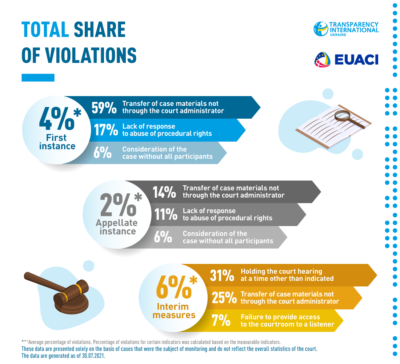Transparency International Ukraine presents the results of an interim comprehensive study of the work of the High Anti-Corruption Court.
On September 5, 2019, the High Anti-Corruption Court went into operation in Ukraine. And since April 1, 2021, TI Ukraine resumed the project of monitoring of its work. The urgency and relevance of this project is explained by the fact that the HACC judges were subject to high requirements for compliance with the criteria of integrity and professionalism. The cases considered by the HACC are the most sensitive for the society, as well as the nature of such criminal offenses themselves.
In fact, the effective operation of the HACC is a response to society's demand for combating grand corruption. Therefore, control by civil society institutions is an integral part of the court's work.
The reporting period covered 4 months: from April 1, 2021 to July 31, 2021.
The purpose of this project was to study the HACC’s compliance with the standards of procedural law and to determine the problem of its interaction with other subjects of criminal proceedings.
Objectives of the study:
- determine the level of the court’s procedural efficiency;
- identify typical violations of procedural law by judges;
- identify violations committed by prosecution and defense, identify the main reasons that lead to reduced efficiency of the court, outline the main trends in the field of judicial practice of the court, describe the main areas of improvement.
General monitoring indicators
- Of the 349 hearings attended, 135 were postponed, which is more than ⅓ of the total number. It is worth noting that out of these 135 hearings, 97 were postponed due to the absence of the defense, and only 13—due to the absence of the prosecution.

- On average, the share of violations is insignificant and is 4% for the first instance, 2% for the appellate instance and 6% for the hearings on the selection / change of interim measures. Among existing violations, the most common ones were singled out.
- In the first instance in 59% of cases the transfer of documents was not carried out through a court administrator, in 17% of cases the court did not take any action to counteract the procedural violation of the parties, in 6% of cases the court considered the case without all relevant participants.
- As for the appellate instance, the main violations here were identical to the first instance, but had smaller shares: 14%, 11% and 6% respectively.
- In hearings on selection / change / cancellation of interim measures, this list included the following violations: transfer of documents not through a court administrator (25%), holding a court hearing not at the appointed time (31%), violations in a judge's appearance (6%), denial of access to courtrooms (7%), lack of open information about the date and time of the hearing (6%).

- Cases on recognizing assets unexplained and their withdrawal to the national budget, i.e. the so-called civil forfeiture, became a major challenge for the court. During the reporting period, the court received two such cases against MPs Kyva and Volynets. However, the court managed to promptly consider and rule on the case in favor of the plaintiff, i.e. the state.
- There have been cases of secrecy of sentences that raise questions about compliance with the law. Given the significant public interest in most HACC cases, the complete secrecy of sentences has a negative effect on the level of public confidence in the institution.
Main findings
- The results of the monitoring of court hearings show a consistently low overall percentage of formal and procedural violations by participants in criminal proceedings. Of course, we can talk about certain trends and patterns, even among the few recorded violations. However, in general, we should note the high level of compliance with legislation and regulations by the participants in the process and the court as a whole.

- Unfortunately, some confrontation between the bar and the HACC continues. The bar organizations, particularly the UNBA, accuse the court of restricting the rights of lawyers and, consequently, clients, and the High Anti-Corruption Court, in turn, has repeatedly appealed to bar organizations with complaints about the actions of certain lawyers.

- Cases that appear in the above-mentioned decisions of the Bar Council of Ukraine are partially monitored. However, during the project, abuse of procedural rights recorded was committed not by the court, but by the defense.

- A number of “classified” decisions were also observed in the monitoring. This practice can hardly be considered positive. Under the current legislation, namely the Criminal Procedural Code and the Law of Ukraine “On Access to Court Decision,” any judicial decision must be made public.
The High Anti-Corruption Court is still a relatively young institution and is still developing its own practices and approaches. That is why it is extremely important to maintain the low level of formal and procedural violations. It is also important to address the controversial and problematic issues that arise in the process of work and interaction with other participants in the criminal process.
Learn more about the results of monitoring in TI Ukraine’s report.
The project is supported by the EU Anti-Corruption Initiative (EUACI), a leading EU-funded anti-corruption support program in Ukraine, co-financed and implemented by the Danish Ministry of Foreign Affairs.

